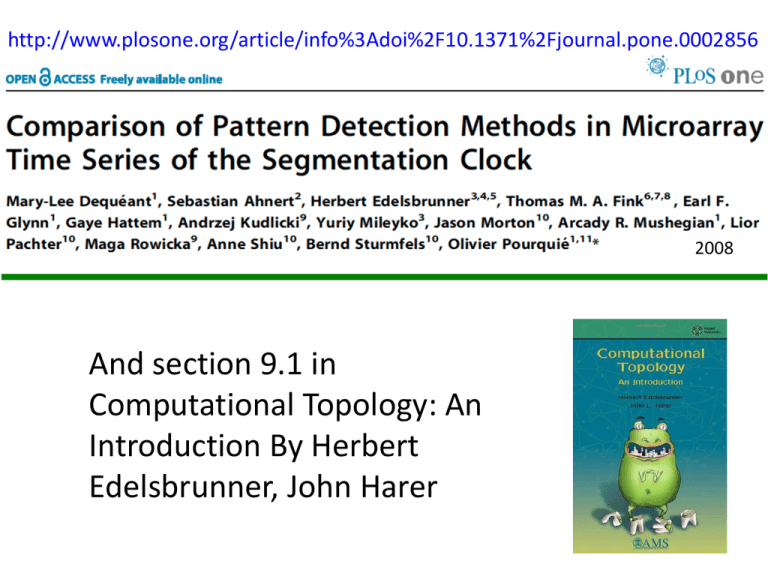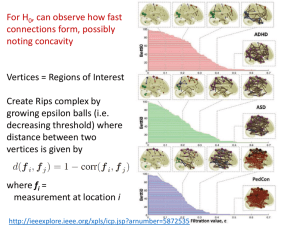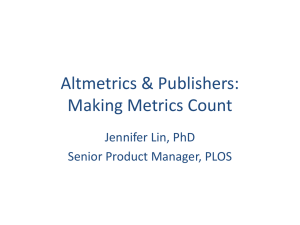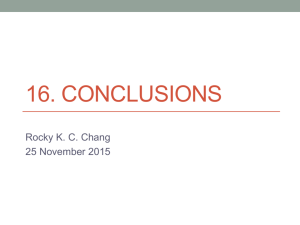Slides
advertisement

http://www.plosone.org/article/info%3Adoi%2F10.1371%2Fjournal.pone.0002856
2008
And section 9.1 in
Computational Topology: An
Introduction By Herbert
Edelsbrunner, John Harer
Goal: To determine what genes are involved in a
particular periodic pathway
Application: segmentation clock of mouse embryo.
• 1 somite develops about every 2 hours
What genes are involved in somite development?
Fig. 2. Identification of cyclic genes based on the PSM microarray time series.
M Dequéant et al. Science 2006;314:1595-1598
Published by AAAS
Not period 2:
Persistence:
For each of 7549 genes, create
fk: S1 R, k = 1, …, 7549
fk (time point i) = amount of RNA at time point i for
gene k
17 time points 17 equally space time points
microarry expression of gene k at time i ranked
order of microarry expression of gene k at time i
(0.41, 0.63, 0.11, 0.23, 0.59, …) (3, 5, 1, 2, 4, …).
fk (time point i) = RNA intensity at time point i for
gene k.
p(fk) = replace RNA intensity with rank order.
g(xi) =[ p(fk)(xi) – 1] / (17 – 1), for i = 1, …, 17.
g(x) obtained by linear interpolation for x ≠ xi for
some i.
Note: 0 ≤ g(x) ≤ 1
Figure 8. Function g(x) for the expression pattern of Axin2.
g: S1 R
( 14, 16 )
( 0, 15 )
16
16
( 15,14 )
( 3, 13 )
16
( 13, 12 )
16
( 1, 11 )
16
16
( 2, 10 )
( 10, 7 )
16
( 12, 9 )
16
( 4, 5 )
16
( 5, 2 )
16
( 6, 0 )
( 8, 3 )
( 9,
16
( 11, 6 )
16
4
16
16
( 16, 8 )
16
)
( 7, 1 )
16
Dequéant M-L, Ahnert S, Edelsbrunner H, Fink TMA, et al. (2008) Comparison of Pattern Detection Methods in Microarray Time Series of the
Segmentation Clock. PLoS ONE 3(8): e2856. doi:10.1371/journal.pone.0002856
http://www.plosone.org/article/info:doi/10.1371/journal.pone.0002856
Not period 2 implies Φq(f) large.
http://journals.plos.org/plosone/article?id=10.1371/journal.pone.0002856
http://journals.plos.org/plosone/article?id=10.1371/journal.pone.0002856
L=LombScargle
analysis;
P=Phase
consistency
A=Address
reduction;
C= Cyclohedron
test;
S=Stable
persistence
The
benchmark
cyclic genes
in bold
were
identified
independently from
the
microarray
analysis
Figure 1. Identification of benchmark cyclic genes in the top 300 probe set lists of the five methods.
Dequéant M-L, Ahnert S, Edelsbrunner H, Fink TMA, et al. (2008) Comparison of Pattern Detection Methods in Microarray Time Series of the
Segmentation Clock. PLoS ONE 3(8): e2856. doi:10.1371/journal.pone.0002856
http://www.plosone.org/article/info:doi/10.1371/journal.pone.0002856
Figure 2. Comparison of the intersection of the top 300 ranked probe sets from the five methods.
Dequéant M-L, Ahnert S, Edelsbrunner H, Fink TMA, et al. (2008) Comparison of Pattern Detection Methods in Microarray Time Series of the
Segmentation Clock. PLoS ONE 3(8): e2856. doi:10.1371/journal.pone.0002856
http://www.plosone.org/article/info:doi/10.1371/journal.pone.0002856
Figure 3. Clustering analysis of the top 300 ranked probe sets from the five methods.
Dequéant ML, Ahnert S, Edelsbrunner H, Fink TMA, Glynn EF, et al. (2008) Comparison of Pattern Detection Methods in Microarray Time Series
of the Segmentation Clock. PLoS ONE 3(8): e2856. doi:10.1371/journal.pone.0002856
http://127.0.0.1:8081/plosone/article?id=info:doi/10.1371/journal.pone.0002856
Table 1. Composition of the Wnt Clusters of the Five Methods.
Dequéant ML, Ahnert S, Edelsbrunner H, Fink TMA, Glynn EF, et al. (2008) Comparison of Pattern Detection Methods in Microarray Time Series
of the Segmentation Clock. PLoS ONE 3(8): e2856. doi:10.1371/journal.pone.0002856
http://127.0.0.1:8081/plosone/article?id=info:doi/10.1371/journal.pone.0002856
Persistent homology results are stable:
Add noise to data does not change barcodes significantly.
http://www.ams.org/publications/authors/books/postpub/mbk-69
Persistent homology
results
stable:
Figure 8. Function
g(x) forare
the expression
pattern of Axin2.
Add noise to data does not change barcodes significantly.
Dequéant M-L, Ahnert S, Edelsbrunner H, Fink TMA, et al. (2008) Comparison of Pattern Detection Methods in Microarray Time Series of the
Segmentation Clock. PLoS ONE 3(8): e2856. doi:10.1371/journal.pone.0002856
http://www.plosone.org/article/info:doi/10.1371/journal.pone.0002856
|| (x1,…,xn) – (y1,…,yn) ||∞ = max{|x1 – y1|,…,|xn - yn|}
Given sets X, Y and bijection g: X Y,
Bottleneck Distance: dB(X, Y) = inf sup || x – g(x) ||∞
g
x
(Wasserstein distance). The p-th Wasserstein
distance between two persistence diagrams,
d1 and d2, is defined as
where g ranges over all bijections from d1 to d2.
Probability measures on the space of
persistence
diagrams
Yuriy Mileyko1, Sayan Mukherjee2 and John Harer1
Persistent homology results are stable:
Add noise to data does not change barcodes significantly.
TDA is a form of Exploratory Data Analysis (EDA)
https://onlinecourses.science.psu.edu/stat857/node/4
Exploratory Data Analysis (EDA) is described as data-driven
hypothesis generation.
http://en.wikipedia.org/wiki/Exploratory_data_analysis
In statistics, exploratory data analysis (EDA) is an approach to
analyzing data sets to summarize their main characteristics, often
with visual methods. A statistical model can be used or not, but
primarily EDA is for seeing what the data can tell us beyond the
formal modeling or hypothesis testing task.
Exploratory data analysis was promoted by John Tukey starting in
the 1960’s.
http://www.jstor.org/discover/10.2307/2392291?uid=3739256&uid=2&uid=4&sid=211060
98896651
Exploratory Data Analysis
John W. Tukey, Princeton University
ISBN-10: 0201076160
ISBN-13: 9780201076165
©1977 • Pearson • Paper, 688 pp
Published 01/01/1977 • Instock
http://www.uta.edu/faculty/sawasthi/Statistics/stdatmin.html#eda1
EDA vs. Hypothesis Testing
As opposed to traditional hypothesis testing designed to verify a
priori hypotheses about relations between variables (e.g., "There is a
positive correlation between the AGE of a person and his/her RISK
TAKING disposition"), exploratory data analysis (EDA) is used to
identify systematic relations between variables when there are no (or
not complete) a priori expectations as to the nature of those relations.
In a typical exploratory data analysis process, many variables are
taken into account and compared, using a variety of techniques in the
search for systematic patterns.
http://www.uta.edu/faculty/sawasthi/Statistics/stdatmin.html#eda1
EDA vs. Hypothesis Testing
Hypothesis testing: verify a priori hypotheses
Exploratory data analysis (EDA): No (or not complete) a priori
expectations as to the nature of those relations.
For H0, can observe how fast
connections form, possibly
noting concavity
Vertices = Regions of Interest
Create Rips complex by
growing epsilon balls (i.e.
decreasing threshold) where
distance between two
vertices is given by
where fi =
measurement at location i
http://ieeexplore.ieee.org/xpls/icp.jsp?arnumber=5872535
Betti numbers provide a signature of the underlying topology.
Use (b0, b1, b2, …) for classification, where bi = rank of Hi
Singh G et al. J Vis 2008;8:11
©2008 by Association for Research in Vision and Ophthalmology
Estimation of topological structure in driven and spontaneous conditions.
•Record voltages at points in time at each electrode.
•Spike train: lists of firing times for a neuron
• obtained via spike sorting –i.e. signal processing.
•Data = an array of N spike trains.
•Compared spontaneous (eyes occluded) to evoked (via
movie clips).
•10 second segments broken into 50 ms bins
•Transistion between states about 80ms
•The 5 neurons with the highest firing rate in each ten
second window were chosen
•For each bin, create a vector in R5 corresponding to the
number of firings of each of the 5 neurons.
•200 bins = 200 data points in R5.
•Used 35 landmark points.
•20-30minutes of data = many data sets
•Control: shuffled data 52700 times.
Singh G et al. J Vis 2008;8:11
©2008 by Association for Research in Vision and Ophthalmology
Combine your analysis with other tools
http://en.wikipedia.org/wiki/Machine_learning
Machine learning is a scientific discipline that explores the
construction and study of algorithms that can learn from data.[1]
Such algorithms operate by building a model from example inputs
and using that to make predictions or decisions,[2]:2 rather than
following strictly static program instructions.
https://www.cs.princeton.edu/courses/archive/spring08/cos511/s
cribe_notes/0204.pdf
Machine learning studies computer algorithms for learning to do
stuff.
The emphasis of machine learning is on automatic methods. In
other words, the goal is to devise learning algorithms that do the
learning automatically without human intervention or assistance.
Image Categorization
Training
Training
Images
Image
Features
Training
Labels
Classifier
Training
Trained
Classifier
Testing
Image
Features
Trained
Classifier
Test Image
http://cs.brown.edu/courses/cs143/lectures/15.ppt
Prediction
Outdoor
cs.brown.edu/courses/cs143/lectures/17.ppt
https://www.python.org/
Download newer 3.4.3 or older 2.7.9 version
https://www.python.org/
Download newer 3.4.3 or older 2.7.9 version
https://www.python.org/downloads/release/python-343/
https://www.python.org/downloads/release/python-343/
Bottom of webpage:
https://www.python.org/downloads/release/python-279/
Bottom of webpage:
https://www.python.org/
https://www.python.org/about/gettingstarted/
https://wiki.python.org/moin/BeginnersGuide/NonProgrammers
python script for comparing 2 files, oldOut.txt and newOut.txt
import itertools
with open('oldOut.txt') as f1, open('newOut.txt') as f2:
for lineno, (line1, line2) in enumerate(itertools.izip(f1, f2), 1):
if line1 != line2:
print line1, line2, 'mismatch', lineno
The above code was modified from:
http://stackoverflow.com/questions/20686674/how-to-comparetwo-files-and-print-mismatched-line-number-in-python
To run and output into a file: python same.py > file.txt
where python script filename: same.py
output filename: file.txt
http://www.python-course.eu/python3_blocks.php
https://www.python.org/dev/peps/pep-0008/#tabs-or-spaces
Tabs or Spaces?
Spaces are the preferred indentation method.
Tabs should be used solely to remain consistent with code that is already indented with
tabs.
Python 3 disallows mixing the use of tabs and spaces for indentation.
Python 2 code indented with a mixture of tabs and spaces should be converted to using
spaces exclusively.
When invoking the Python 2 command line interpreter with the -t option, it issues
warnings about code that illegally mixes tabs and spaces. When using -tt these warnings
become errors. These options are highly recommended!
same.py
import itertools
with open('oldOut.txt') as f1, open('newOut.txt') as f2:
for lineno, (line1, line2) in enumerate(itertools.izip(f1, f2), 1):
if line1 != line2:
print line1, line2, 'mismatch', lineno
file.txt
-1-1-1-1-1-1-1-1Gauss -1 3 -2 1 -3 2
-1-1-1-1-1-1-1-1Gauss: -1 3 -2 1 -3 2
mismatch 1
11111111Gauss 2 -1 3 -2 1 -3
11111111Gauss: 2 -1 3 -2 1 -3
mismatch 11
yamltoR.py
f = open('lesson.yaml',"r")
data_line = f.readlines()
for i in data_line:
if i[:16] == " CorrectAnswer:":
print(i[17:])
f.close()
yamltoRwithComments.py
f = open('lesson.yaml',"r")
data_line = f.readlines()
for i in data_line:
if i[:16] == " CorrectAnswer:":
print(i[17:])
else:
print("#"+i)
f.close()
PEP 8 - Style Guide for Python Code
https://www.python.org/dev/peps/pep-0008/
Possible modifications for next time
------------------------------------------------------ Introduction to data and shape
How did you like
the you tube
lectures?
How did you like
the in-class
worksheets?
Would you have
liked more videos
and in class
worksheets?
---------------------------------------------------------------Computer Lab: Intro to R
HW due 2/5 (individual or group HW): Describe a data set (use feedback from writing center)
Possible modifications for next time
Starting week 1: Class wiki project describing topology including deformation retract.
Draft of commented
R code, due 2/12
Outline due 2/19
Draft OR Poster due 3/12
Possible modifications for next time
Should I ask TA to post deadlines on ICON?
Slides due 4/23
http://www.teachmepython.com/hello-world/
http://interactivepython.org/runestone/static/thinkcspy/toc.html#t-o-c
https://www.python.org/
There are many places to learn python.
•Python For Beginners includes links to a variety of resources
at Python for Non-Programmers and Python for Programmers
•For beginners: codecademy. Intro-active lessons that you can do in
your web browser. You can also learn HTML & CSS, Javascript,
jQuery, Ruby, PHP at Codecademy
•Coursera course
•Python via Lynda. Note Lynda is free to all UI students/staff/faculty
by logging in here







